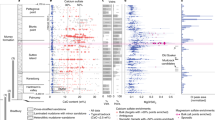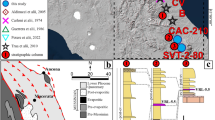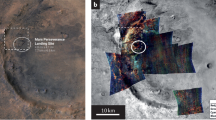Abstract
In situ investigations by the Mars Science Laboratory Curiosity rover have confirmed the presence of an ancient lake that existed in Gale crater for up to 10 million years. The lake was filled with sediments that eventually converted to a compacted sandstone. However, it remains unclear whether the infilling of the lake was the result of background sedimentation processes or represents punctual flooding events in a largely isolated lake. Here, we used the X-ray diffraction data obtained with the Chemistry and Mineralogy instrument onboard the Curiosity rover to characterize the degree of disorder of clay minerals in the Murray formation at Gale crater. Our analysis shows that they are structurally and compositionally related to glauconitic clays, which are a sensitive proxy of quiescent conditions in liquid bodies for extended periods of time. Such results provide evidence of long periods of extremely low sedimentation in an ancient brackish lake on Mars, the signature of an aqueous regime with slow evaporation at low temperatures. More in general, the identification of lacustrine glauconitic clays on Mars provides a key parameter in the characterization of aqueous Martian palaeoenvironments that may once have harboured life.
This is a preview of subscription content, access via your institution
Access options
Access Nature and 54 other Nature Portfolio journals
Get Nature+, our best-value online-access subscription
$29.99 / 30 days
cancel any time
Subscribe to this journal
Receive 12 digital issues and online access to articles
$119.00 per year
only $9.92 per issue
Buy this article
- Purchase on Springer Link
- Instant access to full article PDF
Prices may be subject to local taxes which are calculated during checkout




Similar content being viewed by others
Data availability
Source data are provided with this paper. All data used in this study are freely available from the Planetary Data System database (https://pds.nasa.gov/). The data supporting the findings of this study are available within the paper, in the Supplementary Information file or from the corresponding author upon reasonable request.
References
Dekov, V. M. et al. Hydrothermal nontronite formation at Eolo Seamount (Aeolian volcanic arc, Tyrrhenian Sea). Chem. Geol. 245, 103–119 (2007).
Petit, S., Baron, F. & Decarreau, A. Synthesis of nontronite and other Fe-rich smectites: a critical review. Clay Miner. 52, 469–483 (2017).
Bishop, J. L. et al. Surface clay formation during short-term warmer and wetter conditions on a largely cold ancient Mars. Nat. Astron. 2, 206–213 (2018).
López-Quirós, A., Sánchez-Navas, A., Nieto, F. & Escutia, C. New insights into the nature of glauconite. Am. Mineral. 105, 674–686 (2020).
Thomson, B. J. et al. Constraints on the origin and evolution of the layered mound in Gale Crater, Mars using Mars Reconnaissance Orbiter data. Icarus 214, 413–432 (2011).
Bishop, J., Madejová, J., Komadel, P. & Fröschl, H. The influence of structural Fe, Al and Mg on the infrared OH bands in spectra of dioctahedral smectites. Clay Miner. 37, 607–616 (2002).
Bristow, T. F. & Milliken, R. E. Terrestrial perspective on authigenic clay mineral production in ancient Martian lakes. Clays Clay Miner. 59, 339–358 (2011).
Bristow, T. F. et al. Clay mineral diversity and abundance in sedimentary rocks of Gale crater, Mars. Sci. Adv. https://doi.org/10.1126/sciadv.aar3330 (2018).
Drits, V. A. & Tchoubar, C. X-Ray Diffraction by Disordered Lamellar Structures: Theory and Applications to Microdivided Silicates and Carbons 103–133 (Springer, 2012).
Baldermann, A., Warr, L. N., Grathoff, G. H. & Dietzel, M. The rate and mechanism of deep-sea glauconite formation at the Ivory Coast-Ghana Marginal Ridge. Clays Clay Miner. 61, 258–276 (2013).
López-Quirós, A. et al. Glaucony authigenesis, maturity and alteration in the Weddell Sea: an indicator of paleoenvironmental conditions before the onset of Antarctic glaciation. Sci. Rep. 9, 13580 (2019).
Bansal, U., Banerjee, S. & Nagendra, R. Is the rarity of glauconite in Precambrian Bhima Basin in India related to its chloritization? Precambrian Res. 336, 105509 (2020).
Odin, G. S. & Matter, A. De glauconiarum origine. Sedimentology 28, 611–641 (1981).
Odin, G. S. & Fullagar, P. D. in Developments in Sedimentology Vol. 45 (ed. Odin, G. S.) Ch. 4, 295–332 (Elsevier, 1988).
El Albani, A., Meunier, A. & Fürsich, F. T. Unusual occurrence of glauconite in a shallow lagoonal environment (Lower Cretaceous, northern Aquitaine Basin, SW France). Terra Nova 17, 537–544 (2005).
Fassett, C. I. & Head, J. W.III Valley network-fed, open-basin lakes on Mars: distribution and implications for Noachian surface and subsurface hydrology. Icarus 198, 37–56 (2008).
Lowe, D. R., Bishop, J. L., Loizeau, D., Wray, J. J. & Beyer, R. A. Deposition of >3.7 Ga clay-rich strata of the Mawrth Vallis Group, Mars, in lacustrine, alluvial, and aeolian environments. Geol. Soc. Am. Bull. 132, 17–30 (2019).
Grotzinger, J. P. et al. Deposition, exhumation, and paleoclimate of an ancient lake deposit, Gale crater, Mars Science https://doi.org/10.1126/science.aac7575 (2015).
Rampe, E. B. et al. Mineralogy of an ancient lacustrine mudstone succession from the Murray formation, Gale crater, Mars. Earth Planet. Sci. Lett. 471, 172–185 (2017).
Vaniman, D. T. et al. Mineralogy of a mudstone at Yellowknife Bay, Gale crater, Mars Science https://doi.org/10.1126/science.1243480 (2014).
Chamley, H. Clay Sedimentology (Springer, 1989).
Bailey, S. W. Summary of recommendation of AIPEA Nomenclature Committee. Clay Miner. 15, 85–93 (1980).
Harding, S. C. et al. Mineralogy and geochemistry of the main glauconite bed in the Middle Eocene of Texas: paleoenvironmental implications for the verdine facies. PLoS ONE 9, e87656 (2014).
Bansal, U., Banerjee, S., Ruidas, D. K. & Pande, K. Origin and geochemical characterization of the glauconites in the Upper Cretaceous Lameta Formation, Narmada Basin, central India. J. Palaeogeogr. 7, 99–116 (2018).
Michalski, J. R. et al. Constraints on the crystal-chemistry of Fe/Mg-rich smectitic clays on Mars and links to global alteration trends. Earth Planet. Sci. Lett. 427, 215–225 (2015).
Moore, D. M. & Reynolds, R. C. X-ray diffraction and the identification and analysis of clay minerals. Geol. Mag. 135, 819–842 (1998).
Vaniman, D. T. et al. Gypsum, bassanite, and anhydrite at Gale crater, Mars. Am. Miner. 103, 1011–1020 (2018).
Yamashita, S., Mukai, H., Tomioka, N., Kagi, H. & Suzuki, Y. Iron-rich smectite formation in subseafloor basaltic lava in aged oceanic crust. Sci. Rep. 9, 11306 (2019).
Le Bail, A., Duroy, H. & Fourquet, J. L. Ab-initio structure determination of LiSbWO6 by X-ray powder diffraction. Mater. Res. Bull. 23, 447–452 (1988).
Ufer, K., Kleeberg, R., Bergmann, J. & Dohrmann, R. Rietveld refinement of disordered illite-smectite mixed-layer structures by a recursive algorithm. II: Powder-pattern refinement and quantitative phase analysis. Clays Clay Miner. 60, 535–552 (2012).
Nadeau, P. H., Wilson, M. J., McHardy, W. J. & Tait, J. M. Interstratified clays as fundamental particles. Science 225, 923–925 (1984).
Casas-Cabanas, M., Rodríguez-Carvajal, J. & Palacín, M. R. FAULTS, a new program for refinement of powder diffraction patterns from layered structures. Z. Kristallogr. Cryst. Mater. 23, 243–248 (2006).
Drits, V. A., Varaxina, T. V., Sakharov, B. A. & Plançon, A. A simple technique for identification of one-dimensional powder X-ray diffraction patterns for mixed-layer illite-smectites and other interstratified minerals. Clays Clay Miner. 42, 382–390 (1994).
Drits, V. A. et al. Nature of the structural and crystal-chemical heterogeneity of the Mg-rich glauconite (Riphean, Anabar Uplift). Lithol. Miner. Resour. 45, 555–576 (2010).
McRae, S. G. Glauconite. Earth Sci. Rev. 8, 397–440 (1972).
Hurowitz, J. A. et al. Redox stratification of an ancient lake in Gale crater, Mars. Science 356, eaah6849 (2017).
Bornhold, B. D. & Giresse, P. Glauconitic sediments on the continental shelf off Vancouver Island, British Columbia, Canada. J. Sediment. Res. 55, 653–664 (1985).
Meunier, A. & El Albani, A. The glauconite–Fe‐illite–Fe‐smectite problem: a critical review. Terra Nova 19, 95–104 (2007).
Fairén, A. G., Davila, A. F., Gago-Duport, L., Amils, R. & McKay, C. P. Stability against freezing of aqueous solutions on early Mars. Nature 459, 401–404 (2009).
Fairén, A. G. et al. Cold glacial oceans would have inhibited phyllosilicate sedimentation on early Mars. Nat. Geosci. 4, 667–670 (2011).
Fairén, A. G. et al. Mineral paragenesis on Mars: the roles of reactive surface area and diffusion. J. Geophys. Res. Planets 122, 1855–1879 (2017).
Thompson, L. M. et al. Potassium‐rich sandstones within the Gale impact crater, Mars: the APXS perspective. J. Geophys. Res. Planets 121, 1981–2003 (2016).
Weaver, C. E. Potassium, illite and the ocean. Geochim. Cosmochim. Acta 31, 2181–2196 (1967).
Martin, P. et al. A two‐step K‐Ar experiment on Mars: dating the diagenetic formation of jarosite from Amazonian groundwaters. J. Geophys. Res. Planets 122, 2803–2818 (2017).
Le Deit, L. et al. Sequence of infilling events in Gale Crater, Mars: results from morphology, stratigraphy, and mineralogy. J. Geophys. Res. Planets 118, 2439–2473 (2013).
Peters, G. H. et al. Uniaxial compressive strengths of rocks drilled at Gale Crater, Mars. Geophys. Res. Lett. 45, 108–116 (2018).
Grotzinger, J. P. et al. Mars Science Laboratory Mission and science investigation. Space Sci. Rev. 170, 5–56 (2012).
Blake, D. et al. Characterization and calibration of the CheMin mineralogical instrument on Mars Science Laboratory. Space Sci. Rev. 170, 341–399 (2012).
Rietveld, H. M. Line profiles of neutron powder-diffraction peaks for structure refinement. Acta Crystallogr. 22, 151–152 (1967).
Le Bail, A. in Powder Diffraction: Theory and Practice (eds Dinnebier, R. E. & Billinge, S. J. L.) 134–165 (Royal Society of Chemistry, 2008).
Rodríguez-Carvajal, J. Recent advances in magnetic structure determination by neutron powder diffraction. Physica B Condens. Matter 192, 55–69 (1993).
Roisnel, T. & Rodríquez-Carvajal, J. WinPLOTR: a Windows tool for powder diffraction pattern analysis. Mater. Sci. Forum 378, 118–123 (2001).
Bentor, Y. K. & Kastner, M. Notes on the mineralogy and origin of glauconite. J. Sediment. Res. 35, 155–166 (1965).
Treacy, M. M. J., Newsam, J. M. & Deem, M. W. A general recursion method for calculating diffracted intensities from crystals containing planar faults. Proc. R. Soc. Lond. A 433, 499–520 (1991).
Sakharov, B. et al. X-ray study of the nature of stacking faults in the structure of glauconites. Clay Miner. 25, 419–435 (1990).
Moré, J. J. in Numerical Analysis (ed. Watson, G. A.) 105–116 (Springer, 1978).
Rieder, M. et al. Nomenclature of the micas. Clays Clay Miner. 46, 586–595 (1998).
Parkhurst, D. L. & Appelo, C. A. J. Description of Input and Examples for PHREEQC Version 3—A Computer Program for Speciation, Batch-Rreaction, One-Dimensional Transport, and Inverse Geochemical Calculations Report No. 2328-7055 (US Geological Survey, 2013).
Amorosi, A. The occurrence of glaucony in the stratigraphic record: distribution patterns and sequence-stratigraphic significance. Int. Assoc. Sedimentol. Spec. Publ. 45, 37–54 (2012).
Acknowledgements
We thank T. Bristow for excellent feedback that notably improved the clarity of an early version of this manuscript. We also thank the Mars Science Laboratory team members for their dedication to generating the Planetary Data System database, especially to the CheMin Team. E.L.-A. was supported by the program GRC-ED431C 2017/55 (Xunta de Galicia) granted to the XM-1 group of the Universidade de Vigo, and A.G.F. by the Project ‘MarsFirstWater’, European Research Council Consolidator grant no. 818602.
Author information
Authors and Affiliations
Contributions
E.L.-A. and L.G.-D. conceived the original idea and analysed and interpreted the data. C.G.-L. and A.G.F. contributed to the interpretation of the results and gave technical support and conceptual advice. E.L.-A. and L.G.-D. drafted the manuscript and designed the figures. C.G.-L., A.G.F., J.L.B. and E.B.R. contributed preliminary discussions defining the direction of the project. A.G.F., J.L.B. and E.B.R. provided insights on current results of orbital and in situ measurements on Mars. All authors provided critical feedback and helped shape the research, analysis and manuscript.
Corresponding author
Ethics declarations
Competing interests
The authors declare no competing interests.
Additional information
Peer review information Nature Astronomy thanks Adrián López-Quirós and Peter Ryan for their contribution to the peer review of this work.
Publisher’s note Springer Nature remains neutral with regard to jurisdictional claims in published maps and institutional affiliations.
Extended data
Extended Data Fig. 1 Bulk XRD patterns of drill samples acquired by the CheMin instrument in the Murray formation (Sebina, Quela, and Marimba).
The marked peaks as Kapton represent the signal emitted by the window of the sample holder. The figure also indicates the reflections corresponding to (001) and (02 l) lattice planes of clay minerals.
Extended Data Fig. 2 XRD intensity profiles of ‘nascent’ glauconite with 0 wt. % K2O and ‘intermediate’ glauconite with 4.5 wt. % K2O.
The XRD patterns were calculated with the Rietveld method by using the same structural model (atomic coordinates, lattice parameters, and space group) and identical profile parameters (shape of intensities and scales). No multilayers are considered in the model. It is observable the difference in integrated intensities when the occupation factor of K+ is varied.
Extended Data Fig. 3 Rietveld fits of MB sample using different compositional models for the refinement of the clay mineral phase.
a, Using ‘nascent’ glauconite, without K and low iron content, similar to a ferric collapsed smectite, (b) using glauconite with a 4.5 wt. % K2O and high iron content in the structure. The wt. % values resulting from the Rietveld fits are as follows: a) 28.2 wt. % of ‘nascent’ glauconite, and b) 17.6 wt. % of glauconite (wt. % values are referred to the sum of crystalline phases, excluding the background). χ2 of the refinements are marked at the bottom of the plots. The graphs show the observed intensity, I (obs.), marked with stars, the calculated intensity, I (cal.) (solid line), and the difference between both intensities, I (obs.) - I (cal.) (solid gray line). Bragg’s positions are marked as bars.
Extended Data Fig. 4 Rietveld refinement of the XRD data of SB, QL, and MB.
Le bail method was used to obtain the profile of the clay minerals. Bars (I) indicate the Bragg positions of the different mineral phases in the samples. From top to bottom: Glauconitic clay, andesine, hematite, anhydrite, bassanite, gypsum, sanidine, forsterite, diopside, jarosite, and tridymite. χ2 of the refinements are marked at the bottom of the plots. The graphs show the observed intensity, I (obs.), marked with stars, the calculated intensity, I (cal.) (solid black line), and the difference between both intensities, I (obs.) - I (cal.) (solid golden line).
Extended Data Fig. 5 Comparison between XRD patterns of minerals affected for rotational disorder and the resulting in MB from the Le Bail method.
(a), Top and bottom, XRD patterns (red) of rotationally disordered non-ferric illites showing the broadening effect of n·120° rotations over the set of reflections verifying the condition k = 3n. The upper pattern corresponds to a cis-vacant structure (cv-1Md), as is marked by the diagnostic (111) peak. The bottom pattern corresponds to a trans-vacant disposition (tv-1Md), marked by the absence of (111) peak. In both cases, low iron content is reflected by the diagnostic presence of (002). The blue curve shows the intensity’s profile of MB resulting from the Le Bail method. Here, the absence of (002) corresponds to a clay mineral with high-iron content. The ratio (111) < (−112) is indicative of a tv/cv interstratification, a typical feature of interstratified G-S. The extensive broadening of the set of k = 3n reflections, not affecting the (001) peak is indicative of n·120° rotational disorder. All these features are diagnostic of a mixed layer G-S evolution. (b), Broadening of k = 3n reflections due to random stratification of layers or when rotational disorder of n 60° kind dominates. Upper curve (Blue) correspond to data from MB and the bottom curve (red) correspond to a 4.5 wt. % K2O glauconite, without rotational disorder. The intensities are in arbitrary units.
Extended Data Fig. 6 Redox stratification and location of glauconitic facies into the Gale Crater Lake according with the Goldschmidt sedimentation sequence.
The sedimentary facies displayed to the left are similar to those reported by Hurowitz et al.36 in the Gale crater. These facies correspond to the Goldschmidt sequence14, characterized by the presence of glauconite between coarse/fine-grained detrital sediments and carbonates (on Earth) and saline deposits.
Extended Data Fig. 7 HRTEM lattice fringe image illustrating the glauconitization pathway.
(a), Orientation relations between mature glauconite and ferric smectite. The central glauconite sheets consist of a defect-free regular sequence of 10 Å layers; whereas, the collapsed Fe-smectite show anastomosing d-spacings with abundance of edge dislocations. Both minerals are disposed in a subparallel way, with clear discontinuities between glauconite and smectite layers. The amorphization features of smectite around the border of grains (areas enclosed as circles) suggest a solvent-mediated growth of glauconite at expenses of smectite, in a process similar to Ostwald ripening. There are also appreciable dissolution features and d-spacings of 0.45 nm corresponding to (020) not perpendicular to (001) indicative of rotation between layers. (b), Partially dissolved glauconite after attack by 1 M HCl for 24 h showing the amorphization of the structural framework of tetrahedral and octahedral sheets, although the 10 Å basal repeat is still observable. c) SAED diagram of natural glauconitic mineral showing rotational disorder in the a*b* section. Glauconite samples were obtained from the sediment-water interface at a depth of 200 m from the Galician continental shell (NW of Spain).
Extended Data Fig. 8 Geochemical modeling of the process of dissolution-precipitation between nontronite and glauconite.
The right panels show the trend of Fetot (Fe2+, Fe3+) and K+ along the process. The models were performed at 293 K (a) and b)) and at 273 K (c) and d)). Since the concentration of the solution depends on the initial temperature, the course of salinity is different through the same evaporative process.
Supplementary information
Supplementary Information
Supplementary Tables 1–7, Discussion and Note
Source data
Source Data Fig. 3
Le Bail and FAULTS data
Rights and permissions
About this article
Cite this article
Losa-Adams, E., Gil-Lozano, C., Fairén, A.G. et al. Long-lasting habitable periods in Gale crater constrained by glauconitic clays. Nat Astron 5, 936–942 (2021). https://doi.org/10.1038/s41550-021-01397-x
Received:
Accepted:
Published:
Issue Date:
DOI: https://doi.org/10.1038/s41550-021-01397-x
This article is cited by
-
Ecological successions throughout the desiccation of Tirez lagoon (Spain) as an astrobiological time-analog for wet-to-dry transitions on Mars
Scientific Reports (2023)
-
JWST’s quest for indications of life on planets and exoplanets
Nature Astronomy (2022)



